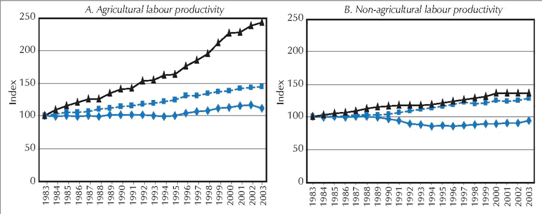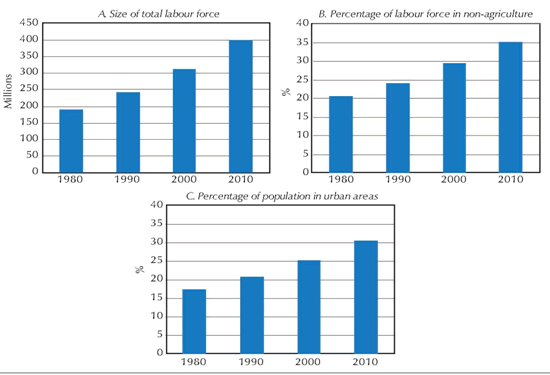Stiff global competition makes jobs crisis particularly difficult to resolve, report says
| EMBARGO The contents of this press release and the related Report must not be quoted or summarized in the print, broadcast or electronic media before 20 July 2006, 17:00 GMT (1 PM New York, 19:00 Geneva) |
The world´s 50 poorest nations are urbanizing without creating productive non-farm jobs, UNCTAD´s Least Developed Countries Report 2006: Developing Productive Capacities(1) says, and they must find a way to foster viable businesses and expand non-agricultural employment when world markets are more competitive than ever and their own markets are wide open.
If this employment challenge is not effectively dealt with, there will be increased pressure for international migration to industrialized countries. Without sustained effort to build the productive base of the poorest countries, it is also likely that there will be increasingly frequent humanitarian emergencies within the least developed countries (LDCs) as well as associated civil conflicts, the report predicts.
Agriculture still employed 70% of the labour force in LDCs in 2000-2003. However, for LDCs as a group, the decade 2000-2010 will be the first in which the growth of the economically active population outside agriculture is predicted to be greater than the growth of the economically active population within agriculture.
Bangladesh, the most populous LDC, is contributing strongly to this trend, but the employment transition will affect more than half of the world´s 50 LDCs this decade, and most of the remainder will follow suit between 2010 and 2020.
Underlying the trend are rapidly growing populations and dwindling amounts of land available for farming. In 33 out of 50 LDCs, the average farm size was under 1 hectare in 2000-2003. Inequalities in land ownership and access are leaving a growing share of the population virtually landless and spurring them to migrate to cities in search of jobs.
The major way in which people have found productive employment in the LDCs in the past has been through expansion of the area of land under agricultural cultivation. But although some LDCs can still be described as being "land-abundant," farms have increasingly been established on marginal land which yields declining returns over time. Widespread extreme poverty in rural areas also means that many farmers cannot afford the steps needed to increase productivity or even to sustain current outputs, the report says. In one-third of LDCs, agricultural labour productivity was lower in 2000-2003 than two decades ago.
Making matters more difficult is that "LDCs must manage this transition in an open-economy context," the report says. "(V)ery few LDCs have restrictive trade regimes at the present moment and most have undertaken rapid and extensive trade liberalization. But their existing production and trade structures offer very limited opportunities in a rapidly globalizing world driven by new knowledge-intensive products with demanding conditions of market entry. At the same time, rapid opening up in more traditional sectors is exposing existing producers to an unprecedented degree of global competition."
So far, it´s not an equal contest, the report says. During 2000-2003, it required five workers in LDCs to produce what one worker produced in other developing countries, and 94 LDC workers to match the productivity of one worker in a developed country. Moreover, the productivity gap between LDCs and other developing countries has been widening.
The inability of LDC farmers to compete even in their own domestic markets is exacerbating the problem of making a basic livelihood in agriculture. In 2000-2003, agricultural labour productivity in LDCs was just 46% of the level in other developing countries, and less than 1% of the level in developed countries.
But on top of this, most LDCs have simply been unable to generate sufficient productive off-farm jobs. Non-agricultural labour productivity declined by 9% for LDCs as a whole between 1980-83 and 2000-2003, the report notes. Moreover, it fell in four-fifths of the 50 LDCs. This is indicative of a major jobs crisis as it is proving impossible in these countries to productively absorb expanding labour forces.
There has been a shift to manufactures exports in a few LDCs. But such manufacturing is concentrated in low-skill, low value-added, labour-intensive products, particularly garments, with weak production linkages with the rest of the economy. Such exports are also highly dependent on special quotas and preferences which remain subject to change.
Substantial and sustained poverty reduction in the LDCs now depends not only on increased agricultural productivity but also on the ability of the economies of poorest countries to produce competitive manufactured goods and services -- for both domestic and world markets. This requires faster physical and human capital formation, faster acquisition and absorption of technologies already in use elsewhere, and innovation in new sectors to create structural changes which will enable increasing returns to scale and external economies. All these processes are weak in most LDCs, the report notes.
The average number of years of schooling of adults in the LDCs was three years in 2000 - less than the level achieved by other developing countries in 1960. The brain drain is also strong: in 2000, one in five of the stock of LDC workers with tertiary educations was working in an OECD country. Bank credit to the private sector in LDCs was only 15% of GDP in the LDCs in 2003, compared with 60% in low- and middle-income countries. Machinery and equipment imports into LDCs - which are the major mechanism through which firms acquire modern technology - were at almost the same level in real per capita terms during 2000-2003 as they were in 1980. And between 1990-1993 and 2000-2003, manufacturing value-added as a share of GDP declined or stagnated in 21 out of 36 LDCs for which data are available.
ANNEX
Tables and figures
Chart 1. Change of agricultural and non-agricultural labour productivity in LDCs, other developing countries and developed countries, 1983-2003
Source: UNCTAD, The Least Developed Countries Report 2006: Developing Productive Capacities, Chart 23
Chart 2. The growth and changing locus of the labour force in LDCs, 1980-2010
Source: UNCTAD, The Least Developed Countries Report 2006: Developing Productive Capacities, Chart 32


